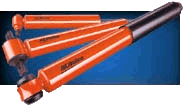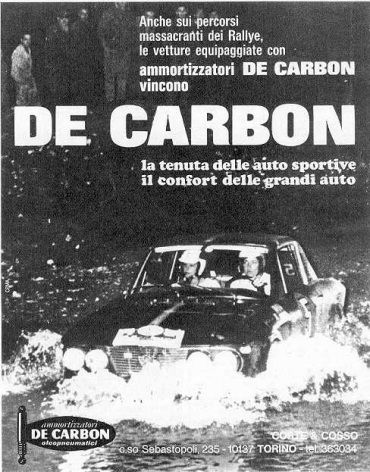 |
De Carbon shock absorbers for Fulvia and S1 Flavia |

The 3 basic types of shock absorber are: - Hydraulic twintube. - Hydraulic low-pressure twintube. - High pressure gas monotube. Christian Bourcier de Carbon founded the De Carbon company in the same year 1953 when he invented the monotube high pressure gas shock absorber. Soon after a license was sold to Bilstein in Germany. Now that the patent has expired also other companies such as Koni use the monotube technology for their top range. Lancia engineers were among the first to recognize the superior performance of the De Carbon shock absorbers and fitted them to the Flavia and Fulvia. Today the De Carbon technology is preferred by car makers such as Ferrari, Lamborgini, Maserati and Lotus. High pressure gas shocks can be mounted under any angle. This is important for the rear shocks of the Flavia / Fulvia. Hydraulic shocks have to be mounted within 45 degrees of upright. |
De Carbon shock absorbers for Fulvia, Flavia 815, 819, 820Prices per shock absorber, front or rear, per January. 20, 2024:
|
|||||||||||||
|
The Stradale, Sports and Competition versions are made to very high standards. High performance. Long life. The sport version has the competition hardware but is tuned just a bit softer. To order and / or for more information contact High performance De Carbon mono tube high pressure gas shock absorbers.All three types of shock absorbers use hydraulic fluid to convert the energy of the spring to heat. The twin tube hydraulic shocks have the shock absorber mechanism in the inner tube. The outer tube functions as a fluid reservoir. The low pressure gas twin tube shock absorbers use low pressure nitrogen in addition to the hydraulic fluid. Whenever a piston moves through a fluid, there is a vacuum behind the piston, which generates bubbles (aeration, foaming). The idea of the low pressure gas is to eliminate the foaming. The high pressure gas shock goes a step further. There is only one tube which holds the shock absorber mechanism and the fluid. At the end of the tube there is a chamber filled with high pressure nitrogen. This chamber is seperated from the main body by a floating piston. The high pressure from the gas makes sure there is no vacuum behind the moving piston (thus no foaming) and eliminates the fluid reservoir. There is no outer tube. |

|
|||||||||||||
|
Instantaneous response
Better fade resistance
Better durability
No need for re-adjustment
|
||||||||||||||